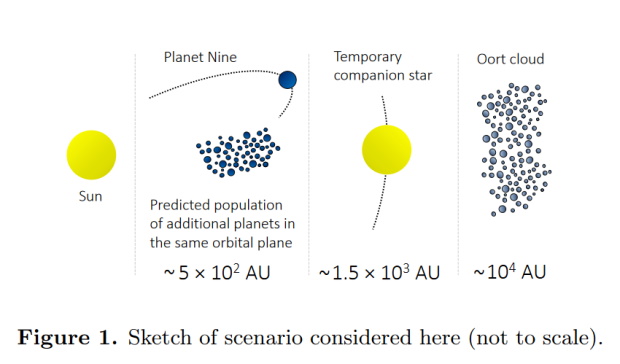It looks like you're using an Ad Blocker.
Please white-list or disable AboveTopSecret.com in your ad-blocking tool.
Thank you.
Some features of ATS will be disabled while you continue to use an ad-blocker.
share:
So a simulation has shown that a binary star system, with two suns orbiting each other, would explain a number of oddities in our current solar
system, like the many Oort Cloud objects and, who would have guessed it, the existence of "Planet Nine". These two phenomena are quite "puzzling"
and apparently difficult for current theories to account for, so maybe we indeed once used to have a solar companion and therefore two suns?
Who could possibly come up with something like that? Well, astrophysicists Dr. Avi Loeb und Amir Siraj (Harvard & Smithsonian Center for Astrophysics) recently published a paper on Cornell University's ARXIV platform introducing their arguments for such a theory. If they're right, it would have certainly been a sight to behold:
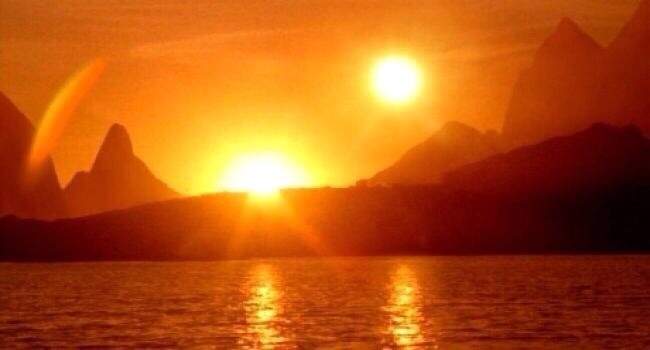
Planet nine, according to the new theory, would have been captured by our own solar system and would therefore have originally been orbiting the second sun or star. The same would be true for the Oort Cloud objects. Quite intriguing if you ask me, and it is all nicely explained (in layman terms) in this article on phys.org.
Here's the abstract of the original paper:
So if this early binary companion, or second sun, did exist one might of course ask: where did it go? To answer that, Loeb and Siraj argue as follows: "Passing stars in the birth cluster would have removed the companion from the sun through their gravitational influence," said Loeb. "Before the loss of the binary, however, the solar system already would have captured its outer envelope of objects, namely the Oort cloud and the Planet Nine population." Siraj added, "The sun's long-lost companion could now be anywhere in the Milky Way."
I thought this might be of interest to some members here in the space exploration forum and I very much look forward to your thoughts on this!
Sources & Links:
-----------------------------------------------------
1. Abstract: The Case for an Early Solar Binary Companion
2. PDF Version: The Case for an Early Solar Binary Companion
3. Further Information About Planet Nine
4. Article: The Sun May Have Started Its Life With A Binary Companion
Who could possibly come up with something like that? Well, astrophysicists Dr. Avi Loeb und Amir Siraj (Harvard & Smithsonian Center for Astrophysics) recently published a paper on Cornell University's ARXIV platform introducing their arguments for such a theory. If they're right, it would have certainly been a sight to behold:

Planet nine, according to the new theory, would have been captured by our own solar system and would therefore have originally been orbiting the second sun or star. The same would be true for the Oort Cloud objects. Quite intriguing if you ask me, and it is all nicely explained (in layman terms) in this article on phys.org.
Here's the abstract of the original paper:
The Case for an Early Solar Binary Companion
We show that an equal-mass, temporary binary companion to the Sun in the solar birth cluster ata separation of∼103AU would have increased the likelihood of forming the observed populationof outer Oort cloud objects and of capturing Planet Nine.
In particular, the discovery of a captured origin for Planet Nine would favor our binary model by an order of magnitude relative to a lone stellarhistory. Our model predicts an overabundance of dwarf planets, discoverable by LSST, with similarorbits to Planet Nine, which would result from capture by the stellar binary.
So if this early binary companion, or second sun, did exist one might of course ask: where did it go? To answer that, Loeb and Siraj argue as follows: "Passing stars in the birth cluster would have removed the companion from the sun through their gravitational influence," said Loeb. "Before the loss of the binary, however, the solar system already would have captured its outer envelope of objects, namely the Oort cloud and the Planet Nine population." Siraj added, "The sun's long-lost companion could now be anywhere in the Milky Way."
I thought this might be of interest to some members here in the space exploration forum and I very much look forward to your thoughts on this!
Sources & Links:
-----------------------------------------------------
1. Abstract: The Case for an Early Solar Binary Companion
2. PDF Version: The Case for an Early Solar Binary Companion
3. Further Information About Planet Nine
4. Article: The Sun May Have Started Its Life With A Binary Companion
a reply to: jeep3r
Anywhere? Could it still be a part of our solar system? Maybe it turned into a Black dwarf long ago and is naturally stealthy.
Fun read, thanks for posting.
So if this early binary companion, or second sun, did exist one might of course ask: where did it go? To answer that, Loeb and Siraj argue as follows: "Passing stars in the birth cluster would have removed the companion from the sun through their gravitational influence," said Loeb. "Before the loss of the binary, however, the solar system already would have captured its outer envelope of objects, namely the Oort cloud and the Planet Nine population." Siraj added, "The sun's long-lost companion could now be anywhere in the Milky Way."
Anywhere? Could it still be a part of our solar system? Maybe it turned into a Black dwarf long ago and is naturally stealthy.
Fun read, thanks for posting.
a reply to: hombero
I think it's easier to relate to the term "two suns" or "second sun" as opposed to "binary star system/binary companion", which is of course also mentioned in the OP. But you do have a point there, I admit.
I think it's easier to relate to the term "two suns" or "second sun" as opposed to "binary star system/binary companion", which is of course also mentioned in the OP. But you do have a point there, I admit.
edit on 21-8-2020 by jeep3r because: text
a reply to: LookingAtMars
Not sure regarding its whereabouts or how far away it would be, I'm definitely not an expert. But wouldn't it be great to one day locate our lost stellar companion (if there indeed was one)?
And thanks again for your input, much appreciated!
Not sure regarding its whereabouts or how far away it would be, I'm definitely not an expert. But wouldn't it be great to one day locate our lost stellar companion (if there indeed was one)?
And thanks again for your input, much appreciated!
I have always thought Jupiter....a gas giant...to be a sun who's ignition never really got up and running.
a reply to: Spacespider
A truly memorable moment in sci-fi history, I should have included that in the OP...
Thanks for posting!
A truly memorable moment in sci-fi history, I should have included that in the OP...
Thanks for posting!
I personally have believed and will continue to believe until proven otherwise that there is a twin to our sun and it may be a dwarf or any number of
things but is on its way back to us.
Many changes in the solar system and I don't like the way the science is doing just what the COVID people have been doing changing their stories back and forth every few months.
The thing is not to believe every thing you are told because it is science. They have changed everything that was a "sure" known thing over the years. Like the Big Bang pretty much out of popularity after being taught as a true thing for so many years.
Why is it they know what gasses are coming from this distant object now but having a orbiting craft above Ceres and they only recently "know" the white material is just plain old salt. Pretty reasonable to think they have ways of recognizing this material sodium easily by now.
Could the out gassing of Comet C/2017 K2 (PANSTARRS) be related?
www.abovetopsecret.com...
Many changes in the solar system and I don't like the way the science is doing just what the COVID people have been doing changing their stories back and forth every few months.
The thing is not to believe every thing you are told because it is science. They have changed everything that was a "sure" known thing over the years. Like the Big Bang pretty much out of popularity after being taught as a true thing for so many years.
Why is it they know what gasses are coming from this distant object now but having a orbiting craft above Ceres and they only recently "know" the white material is just plain old salt. Pretty reasonable to think they have ways of recognizing this material sodium easily by now.
Could the out gassing of Comet C/2017 K2 (PANSTARRS) be related?
“K2 is so far from the Sun and so cold, we know for sure that the activity — all the fuzzy stuff making it look like a comet — is not produced, as in other comets, by the evaporation of water ice,” Dr. Jewitt explained.
“Instead, we think the activity is due to the sublimation of super-volatiles as K2 makes its maiden entry into the Solar System’s planetary zone. That’s why it’s special. This comet is so far away and so incredibly cold that water ice there is frozen like a rock.”
Observations of the thickness of Pluto’s atmosphere in 2002 suggested the dwarf planet was warming even as its orbit took it further from the Sun. The finding baffled astronomers at the time, and the cause has yet to be determined.
Read more: www.newscientist.com...
www.abovetopsecret.com...
a reply to: jeep3r
So how does an outside influence pull a star out of our solar system but not the other objects out there on that envelope. You'd think those smaller objects would feel that gravitational effect more so than a star right? It is an interesting theory though...maybe we lost the star in some other way.
So how does an outside influence pull a star out of our solar system but not the other objects out there on that envelope. You'd think those smaller objects would feel that gravitational effect more so than a star right? It is an interesting theory though...maybe we lost the star in some other way.
originally posted by: LookingAtMars
a reply to: jeep3r
So if this early binary companion, or second sun, did exist one might of course ask: where did it go? To answer that, Loeb and Siraj argue as follows: "Passing stars in the birth cluster would have removed the companion from the sun through their gravitational influence," said Loeb. "Before the loss of the binary, however, the solar system already would have captured its outer envelope of objects, namely the Oort cloud and the Planet Nine population." Siraj added, "The sun's long-lost companion could now be anywhere in the Milky Way."
Anywhere? Could it still be a part of our solar system? Maybe it turned into a Black dwarf long ago and is naturally stealthy.
Fun read, thanks for posting.
Because the time required for a white dwarf to reach this state is calculated to be longer than the current age of the universe (13.8 billion years), no black dwarfs are expected to exist in the universe now, and the temperature of the coolest white dwarfs is one observational limit on the age of the universe.[1]
From your link.
A horde of stragglers lurking in the dark haha...the oort cloud is spooky.
In a binary system I think there should be a few more rocky planets as they are made closer to a star, So two stars means more chances of rocky
planets, We could have a few missing planets,
a reply to: BelowLowAnnouncement
Thanks for pointing that out.
We don't know enough about the universe to be sure, IMO. Humans have been no farther than the moon.
no black dwarfs are expected to exist in the universe now
Thanks for pointing that out.
We don't know enough about the universe to be sure, IMO. Humans have been no farther than the moon.
originally posted by: LookingAtMars
a reply to: BelowLowAnnouncement
no black dwarfs are expected to exist in the universe now
Thanks for pointing that out.
We don't know enough about the universe to be sure, IMO. Humans have been no farther than the moon.
Honestly it was a solid idea, if I had read your post a few days ago I would have been supportive of your theory, but by random coincidence I happened to encounter the term 'black dwarf' in a documentary a few days ago and learned this so I double checked your link to jog my memory.
youtu.be...
That was the documentary I watched, the black dwarf part is at about 7 minutes in, but its honestly an amazing and easy to watch compilation of information if you get bored some time.
a reply to: jeep3r
We are in a relationship with the star Sirius. It is not a binary relationship as Sirius is a binary / trianry system in its own accord. The cycle is a 25920 year cycle and the knowledge is on the wall in the ancient teachings and modern occultic societies.
I could do a lot of writing on this but there is a thread up if you are interested.
We are in a relationship with the star Sirius. It is not a binary relationship as Sirius is a binary / trianry system in its own accord. The cycle is a 25920 year cycle and the knowledge is on the wall in the ancient teachings and modern occultic societies.
I could do a lot of writing on this but there is a thread up if you are interested.
a reply to: purplemer
Well, it is the brightest star in the sky. Yes. So people have noticed it for quite a while. Ever since they noticed the sky.
We are in a relationship with the star Sirius.
Well, it is the brightest star in the sky. Yes. So people have noticed it for quite a while. Ever since they noticed the sky.
Precession has nothing to do with Sirius.
The cycle is a 25920 year cycle
edit on 8/22/2020 by Phage because: (no reason given)
a reply to: Phage
Helllo Phage that in its self is a debatable statement. According to ancient teachings these two things are very muh linked.
Have you had a look at the back of my mega thread you will see some work has been done that suggests this may be the case.
I used one degree each way of the latitude horizon and found Sirius rising with the Sun from 4042 BC to 1681 BC, this also shows the precession of Regulus that actually sits on the Ecliptic, however this gets out of sync both ways at both ends, and ends up staggered, showing only for some years. This shows something mysterious happening as Sirius isn't acting like other stars regarding precession for over 2,000 years! Astronomy pictures below, as yet i haven't found any location other than the latitude of Cairo
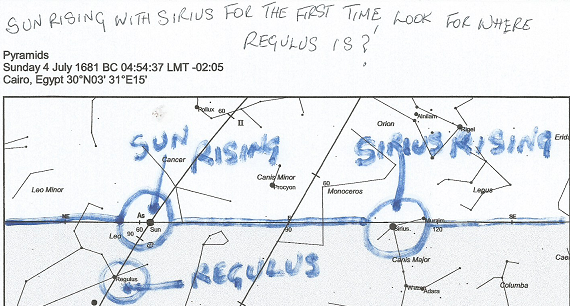
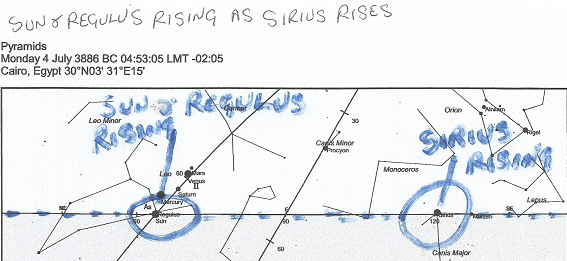
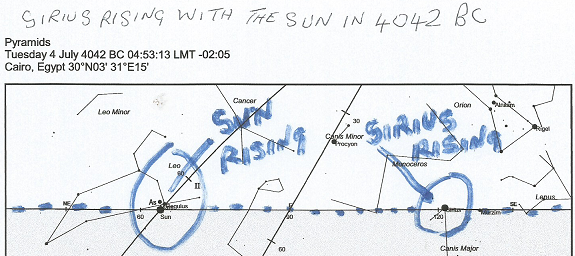
Heck as I stated its a been used a time keeper in preference to our sun in may cultures. Notabley the Mayans / Kemetics and Vedics and coincindelty ours two in which Sirius lines up local time new years eve.
Sirius is the time keeper!
The cycle is a 25920 year cycle Precession has nothing to do with Sirius.
Helllo Phage that in its self is a debatable statement. According to ancient teachings these two things are very muh linked.
Have you had a look at the back of my mega thread you will see some work has been done that suggests this may be the case.
I used one degree each way of the latitude horizon and found Sirius rising with the Sun from 4042 BC to 1681 BC, this also shows the precession of Regulus that actually sits on the Ecliptic, however this gets out of sync both ways at both ends, and ends up staggered, showing only for some years. This shows something mysterious happening as Sirius isn't acting like other stars regarding precession for over 2,000 years! Astronomy pictures below, as yet i haven't found any location other than the latitude of Cairo



Heck as I stated its a been used a time keeper in preference to our sun in may cultures. Notabley the Mayans / Kemetics and Vedics and coincindelty ours two in which Sirius lines up local time new years eve.
Sirius is the time keeper!
new topics
-
Weinstein's conviction overturned
Mainstream News: 34 minutes ago -
Supreme Court Oral Arguments 4.25.2024 - Are PRESIDENTS IMMUNE From Later Being Prosecuted.
Above Politics: 2 hours ago -
Krystalnacht on today's most elite Universities?
Social Issues and Civil Unrest: 2 hours ago -
Chris Christie Wishes Death Upon Trump and Ramaswamy
Politicians & People: 2 hours ago -
University of Texas Instantly Shuts Down Anti Israel Protests
Education and Media: 4 hours ago -
Any one suspicious of fever promotions events, major investor Goldman Sachs card only.
The Gray Area: 6 hours ago -
God's Righteousness is Greater than Our Wrath
Religion, Faith, And Theology: 11 hours ago
top topics
-
VP's Secret Service agent brawls with other agents at Andrews
Mainstream News: 15 hours ago, 11 flags -
Nearly 70% Of Americans Want Talks To End War In Ukraine
Political Issues: 16 hours ago, 6 flags -
Krystalnacht on today's most elite Universities?
Social Issues and Civil Unrest: 2 hours ago, 6 flags -
Sunak spinning the sickness figures
Other Current Events: 16 hours ago, 5 flags -
Supreme Court Oral Arguments 4.25.2024 - Are PRESIDENTS IMMUNE From Later Being Prosecuted.
Above Politics: 2 hours ago, 5 flags -
Weinstein's conviction overturned
Mainstream News: 34 minutes ago, 4 flags -
Electrical tricks for saving money
Education and Media: 14 hours ago, 4 flags -
University of Texas Instantly Shuts Down Anti Israel Protests
Education and Media: 4 hours ago, 2 flags -
Any one suspicious of fever promotions events, major investor Goldman Sachs card only.
The Gray Area: 6 hours ago, 2 flags -
Chris Christie Wishes Death Upon Trump and Ramaswamy
Politicians & People: 2 hours ago, 1 flags
active topics
-
University of Texas Instantly Shuts Down Anti Israel Protests
Education and Media • 100 • : CriticalStinker -
Supreme Court Oral Arguments 4.25.2024 - Are PRESIDENTS IMMUNE From Later Being Prosecuted.
Above Politics • 14 • : TzarChasm -
Nearly 70% Of Americans Want Talks To End War In Ukraine
Political Issues • 77 • : Consvoli -
British TV Presenter Refuses To Use Guest's Preferred Pronouns
Education and Media • 159 • : 5thHead -
-@TH3WH17ERABB17- -Q- ---TIME TO SHOW THE WORLD--- -Part- --44--
Dissecting Disinformation • 669 • : Justoneman -
HORRIBLE !! Russian Soldier Drinking Own Urine To Survive In Battle
World War Three • 40 • : Myhandle -
Weinstein's conviction overturned
Mainstream News • 7 • : underpass61 -
President BIDEN Vows to Make Americans Pay More Federal Taxes in 2025 - Political Suicide.
2024 Elections • 144 • : underpass61 -
Sunak spinning the sickness figures
Other Current Events • 19 • : Freeborn -
Candidate TRUMP Now Has Crazy Judge JUAN MERCHAN After Him - The Stormy Daniels Hush-Money Case.
Political Conspiracies • 746 • : matafuchs

